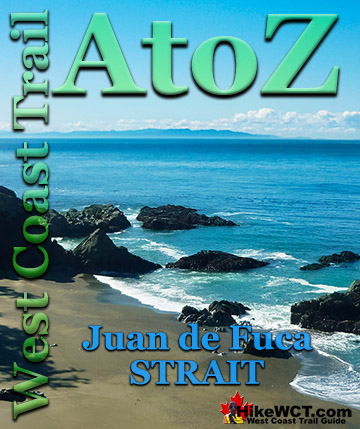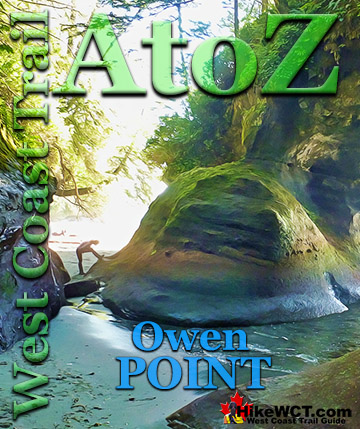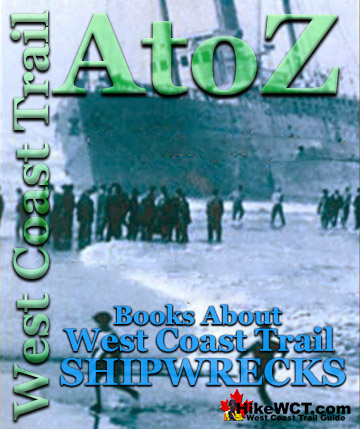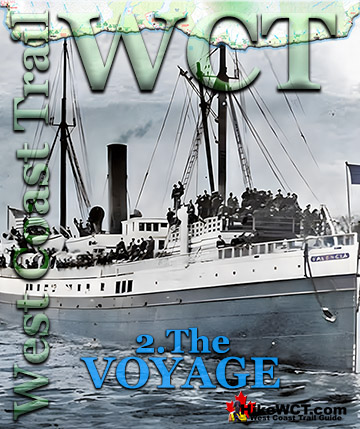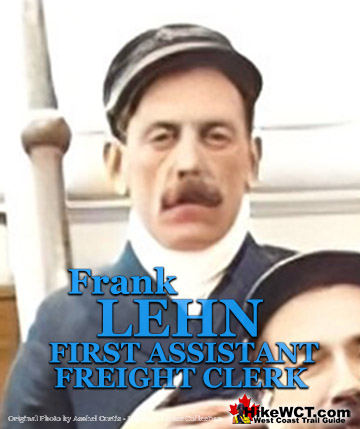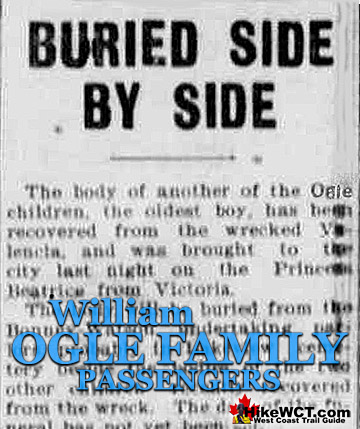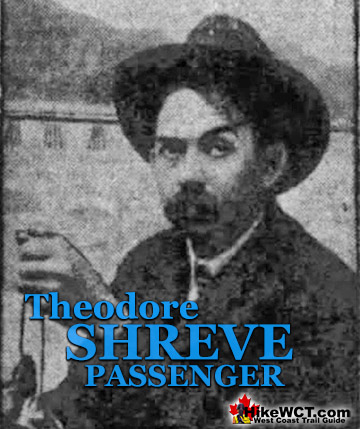Shipwrecks of the West Coast Trail
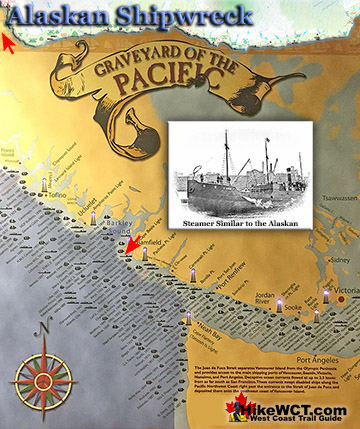
![]() The Alaskan was a small, wooden hulled steamship of 150 tons built in Oregon in 1886. She was owned by a Vancouver freight company and was on route to Kildonan in Barkley Sound with 100 tons of box shooks(metal fittings to construct wooden crates). The West Coast Trail maps given to hikers list the cargo as salt, which appears to be incorrect.
The Alaskan was a small, wooden hulled steamship of 150 tons built in Oregon in 1886. She was owned by a Vancouver freight company and was on route to Kildonan in Barkley Sound with 100 tons of box shooks(metal fittings to construct wooden crates). The West Coast Trail maps given to hikers list the cargo as salt, which appears to be incorrect.
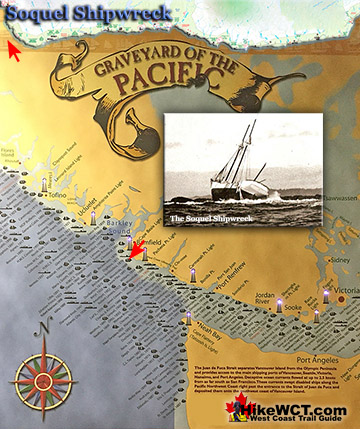
![]() The Soquel shipwreck, which lies just past Seabird Rocks, was a much larger ship than the Alaskan at 698 tons. She was a four masted schooner built in San Francisco, California in 1902. The Soquel was sailing with ballast from Callao, Peru, heading for Port Townsend (near Seattle), when bad weather and high seas carried her far off course.
The Soquel shipwreck, which lies just past Seabird Rocks, was a much larger ship than the Alaskan at 698 tons. She was a four masted schooner built in San Francisco, California in 1902. The Soquel was sailing with ballast from Callao, Peru, heading for Port Townsend (near Seattle), when bad weather and high seas carried her far off course.
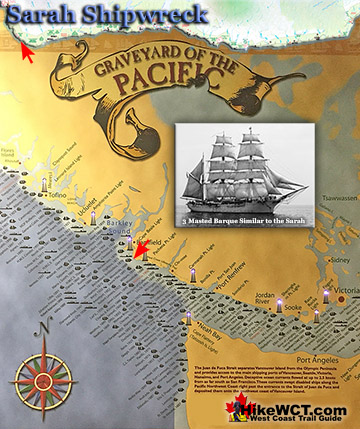
![]() Seven kilometres into the West Coast Trail you will come to the shipwreck of the Sarah, hidden under the waves near the shoreline route of the trail. The Sarah was a three masted barque of 1206 tons, built in Nova Scotia in 1874. A British ship, she was sailing from the Philippines in ballast(no cargo), heading for Puget Sound. The crew consisted of 18 men as well as the captain's wife and baby.
Seven kilometres into the West Coast Trail you will come to the shipwreck of the Sarah, hidden under the waves near the shoreline route of the trail. The Sarah was a three masted barque of 1206 tons, built in Nova Scotia in 1874. A British ship, she was sailing from the Philippines in ballast(no cargo), heading for Puget Sound. The crew consisted of 18 men as well as the captain's wife and baby.
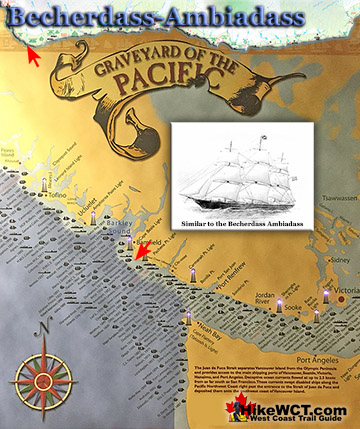
![]() Built in 1864 the 1376 ton, 3 masted ship, Becherdass-Ambiadass was wrecked on the rocky shore only a half mile from Pachena Point. This British ship was returning from Shanghai to Moodyville (now North Vancouver) when Cape Beale was sighted. As she neared Vancouver Island early morning fog blinded her and under full sail collided with the abruptly rocky shore near the 8km mark of the West Coast Trail on July 27th, 1879.
Built in 1864 the 1376 ton, 3 masted ship, Becherdass-Ambiadass was wrecked on the rocky shore only a half mile from Pachena Point. This British ship was returning from Shanghai to Moodyville (now North Vancouver) when Cape Beale was sighted. As she neared Vancouver Island early morning fog blinded her and under full sail collided with the abruptly rocky shore near the 8km mark of the West Coast Trail on July 27th, 1879.
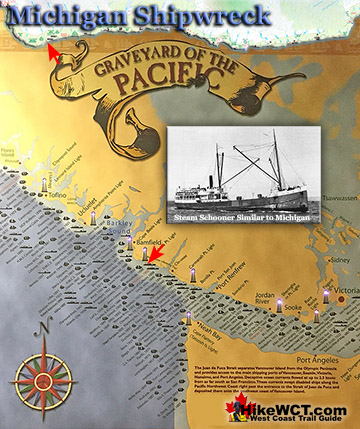
![]() On the West Coast Trail at the 12 kilometre mark you will come to the Michigan. The Michigan shipwreck on the West Coast Trail is the first one you can see and actually touch, which is incredible since it is well over a century old. On January 21st, 1893 this 695 ton steam schooner was heading to Puget Sound from San Francisco.
On the West Coast Trail at the 12 kilometre mark you will come to the Michigan. The Michigan shipwreck on the West Coast Trail is the first one you can see and actually touch, which is incredible since it is well over a century old. On January 21st, 1893 this 695 ton steam schooner was heading to Puget Sound from San Francisco.
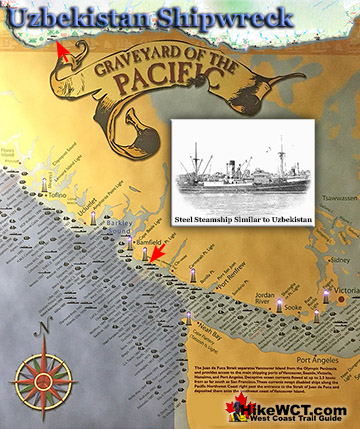
![]() The Uzbekistan was a steel steamship of 2569 tons. Built in 1937 in France and became a shipwreck on April 1st, 1943. A Russian ship, the Uzbekistan was part of the lend-lease program during World War II, where the US shipped war materials to Russia. She left Portland for Seattle to pick up a load of war materials destined for Vladivostok.
The Uzbekistan was a steel steamship of 2569 tons. Built in 1937 in France and became a shipwreck on April 1st, 1943. A Russian ship, the Uzbekistan was part of the lend-lease program during World War II, where the US shipped war materials to Russia. She left Portland for Seattle to pick up a load of war materials destined for Vladivostok.
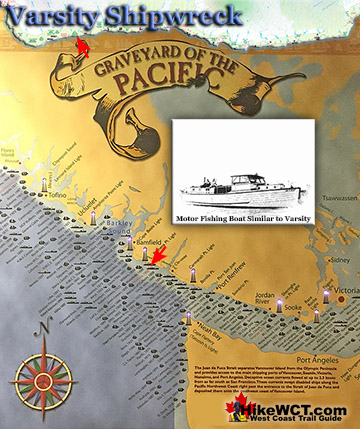
![]() The Varsity was a fishing boat of 90 tons, returning to Puget Sound from California on February 5th, 1940. In bad weather and stormy seas, she abruptly struck the shore, just a kilometre past, what is today, Tsocowis Creek on the West Coast Trail. The Varsity had overrun her position due to the fast northerly current and was driven into the Graveyard of the Pacific.
The Varsity was a fishing boat of 90 tons, returning to Puget Sound from California on February 5th, 1940. In bad weather and stormy seas, she abruptly struck the shore, just a kilometre past, what is today, Tsocowis Creek on the West Coast Trail. The Varsity had overrun her position due to the fast northerly current and was driven into the Graveyard of the Pacific.
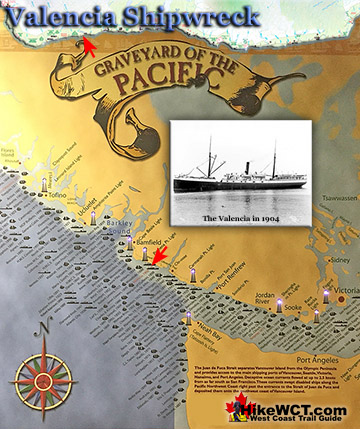
![]() The Daily Colonist newspaper on the 3rd of May, 1906 reported, “On Monday another body of a victim of the wreck of the Valencia, the decomposed corpse of a child, was picked up by Mr. Logan in the vicinity of the wreck, and was buried. The body could not be identified. There are now thirteen bodies buried in the shallow graves on the sandy beach, not far from the scene of the wreck, all unidentified.
The Daily Colonist newspaper on the 3rd of May, 1906 reported, “On Monday another body of a victim of the wreck of the Valencia, the decomposed corpse of a child, was picked up by Mr. Logan in the vicinity of the wreck, and was buried. The body could not be identified. There are now thirteen bodies buried in the shallow graves on the sandy beach, not far from the scene of the wreck, all unidentified.

![]() The Janet Cowan was a steel sailing vessel, four-masted, bark rigged, of 2498 tons built at Glasgow in 1889. She was wrecked at about the 19 kilometre mark on the West Coast Trail with several lives lost. The Janet Cowan shipwreck shone a light on the necessity of building more lighthouses and constructing a coastal lifesaving trail. Little was done, however, and just 10 years later, and less than a kilometre away, the Valencia met a similar fate.
The Janet Cowan was a steel sailing vessel, four-masted, bark rigged, of 2498 tons built at Glasgow in 1889. She was wrecked at about the 19 kilometre mark on the West Coast Trail with several lives lost. The Janet Cowan shipwreck shone a light on the necessity of building more lighthouses and constructing a coastal lifesaving trail. Little was done, however, and just 10 years later, and less than a kilometre away, the Valencia met a similar fate.
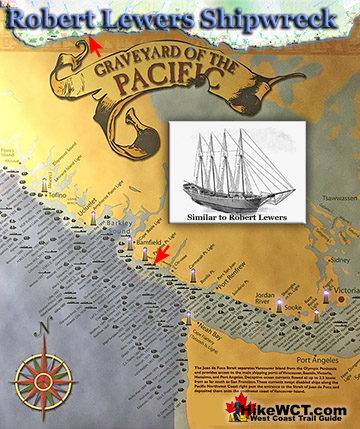
![]() The Robert Lewers was a 185 foot, four masted schooner of 732 tons, built in Port Blakely, Washington in 1889. She was wrecked just past kilometre 19 on the West Coast Trail, just half a kilometre from the Janet Cowen shipwreck, and less than two kilometres from the Valencia shipwreck. The Robert Lewers entered the Graveyard of the Pacific on the 11th of April, 1923. The ship was heading for Bellingham, Washington in ballast from Honolulu with a crew of 14.
The Robert Lewers was a 185 foot, four masted schooner of 732 tons, built in Port Blakely, Washington in 1889. She was wrecked just past kilometre 19 on the West Coast Trail, just half a kilometre from the Janet Cowen shipwreck, and less than two kilometres from the Valencia shipwreck. The Robert Lewers entered the Graveyard of the Pacific on the 11th of April, 1923. The ship was heading for Bellingham, Washington in ballast from Honolulu with a crew of 14.

![]() Just past the 20 kilometre mark of the West Coast Trail you will find an anchor of the Woodside on the beach. The Woodside, an 87 foot long steamer built in Sooke, British Columbia in 1878. Sooke is the small town located about halfway between Victoria and Port Renfew at the south end of the West Coast Trail. The Woodside provided regular service between Victoria, Port Renfrew, Barkley Sound, and the Albernie Canal.
Just past the 20 kilometre mark of the West Coast Trail you will find an anchor of the Woodside on the beach. The Woodside, an 87 foot long steamer built in Sooke, British Columbia in 1878. Sooke is the small town located about halfway between Victoria and Port Renfew at the south end of the West Coast Trail. The Woodside provided regular service between Victoria, Port Renfrew, Barkley Sound, and the Albernie Canal.
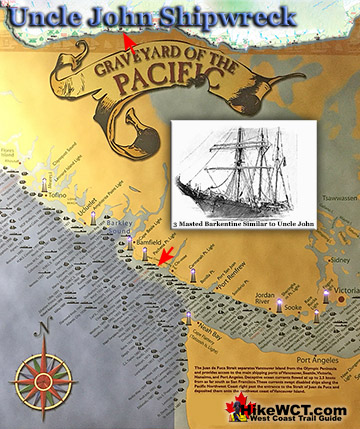
![]() The Uncle John was a 138 foot, three masted barkentine of 314 tons. Built in Eureka, California in 1881 and wrecked one kilometre east of Tsusiat Falls on the West Coast Trail. She was inbound in ballast from Hololulu, heading to Port Townsend. Owing to awful weather and heavy seas, the captain and crew of four were unable to obtain any sights. At 2am on the morning of 6 October, 1899, finally a lighthouse was spotted and it was thought to be the Carmanah Point Lighthouse.
The Uncle John was a 138 foot, three masted barkentine of 314 tons. Built in Eureka, California in 1881 and wrecked one kilometre east of Tsusiat Falls on the West Coast Trail. She was inbound in ballast from Hololulu, heading to Port Townsend. Owing to awful weather and heavy seas, the captain and crew of four were unable to obtain any sights. At 2am on the morning of 6 October, 1899, finally a lighthouse was spotted and it was thought to be the Carmanah Point Lighthouse.
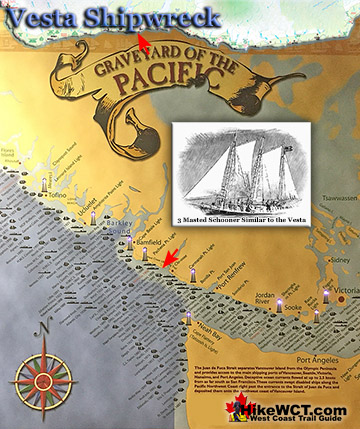
![]() At about 29 kilometres on the West Coast Trail you will pass the Vesta shipwreck. This 3 masted schooner of 286 tons was wrecked here on November 10th, 1897. This 128 foot long sailing ship was primarily used to ship lumber to California. The Vesta was inbound from California in ballast to Port Blakely Mills on Bainbridge Island, Washington.
At about 29 kilometres on the West Coast Trail you will pass the Vesta shipwreck. This 3 masted schooner of 286 tons was wrecked here on November 10th, 1897. This 128 foot long sailing ship was primarily used to ship lumber to California. The Vesta was inbound from California in ballast to Port Blakely Mills on Bainbridge Island, Washington.
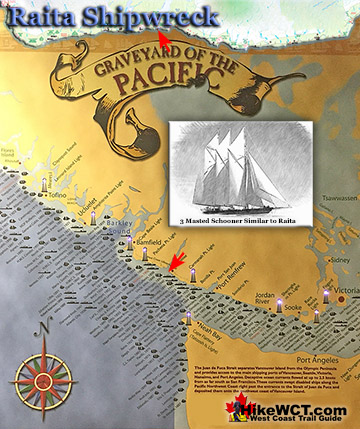
![]() The Raita shipwreck is located off the reefs at about the 33 kilometre mark of the West Coast Trail. Located just offshore and most remnants of this wreck are hidden under the waves. Some of the hull timbers can still be seen by the determined, just down from the river bed near Whyac Point. This section of the West Coast Trail is quite far inland, away from the coast, so you won't likely even get to look over the sea where she met her end.
The Raita shipwreck is located off the reefs at about the 33 kilometre mark of the West Coast Trail. Located just offshore and most remnants of this wreck are hidden under the waves. Some of the hull timbers can still be seen by the determined, just down from the river bed near Whyac Point. This section of the West Coast Trail is quite far inland, away from the coast, so you won't likely even get to look over the sea where she met her end.

![]() The Skagit, a 3 masted barkentine of 506 tons was wrecked on the reef in front of Clo-oose on what is now the West Coast Trail. This 156 foot ship was built in Port Ludlow, Washington in 1883 and was primarily used to ship lumber down the coast to San Francisco. The Skagit was sailing in from San Francisco in ballast to Port Gamble, Washington to load lumber.
The Skagit, a 3 masted barkentine of 506 tons was wrecked on the reef in front of Clo-oose on what is now the West Coast Trail. This 156 foot ship was built in Port Ludlow, Washington in 1883 and was primarily used to ship lumber down the coast to San Francisco. The Skagit was sailing in from San Francisco in ballast to Port Gamble, Washington to load lumber.
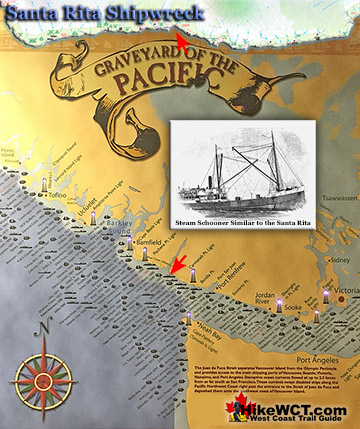
![]() Near the 37 kilometre mark on the West Coast Trail you will pass the Santa Rita, a 100 year old shipwreck hidden under the waves. The Santa Rita was a steel steam schooner, built in San Francisco in 1913. On February 15th, 1923 at 520am, this 235 foot long, 1600 ton ship collided head on with the the small island reef just a few hundred metres from the beach.
Near the 37 kilometre mark on the West Coast Trail you will pass the Santa Rita, a 100 year old shipwreck hidden under the waves. The Santa Rita was a steel steam schooner, built in San Francisco in 1913. On February 15th, 1923 at 520am, this 235 foot long, 1600 ton ship collided head on with the the small island reef just a few hundred metres from the beach.
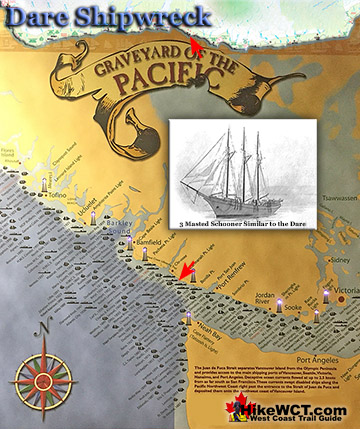
![]() You will pass the Dare shipwreck at the 39 kilometre mark of the West Coast Trail. The Graveyard of the Pacific claimed this 3 masted, 269 ton schooner on December 23rd, 1890. The Dare sailed out of San Francisco in ballast for Tacoma to take on a load of lumber. In the middle of the winter, stormy season along this coast, the Dare was caught in a typically brutal storm.
You will pass the Dare shipwreck at the 39 kilometre mark of the West Coast Trail. The Graveyard of the Pacific claimed this 3 masted, 269 ton schooner on December 23rd, 1890. The Dare sailed out of San Francisco in ballast for Tacoma to take on a load of lumber. In the middle of the winter, stormy season along this coast, the Dare was caught in a typically brutal storm.
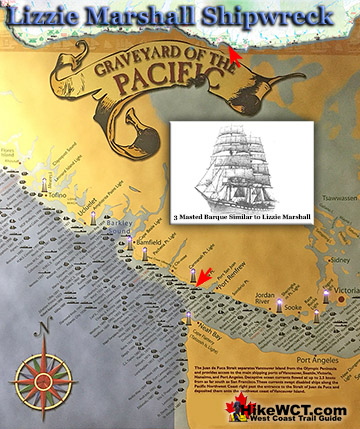
![]() Near KM47 along the West Coast Trail you will pass the final resting place of the Lizzie Marshall. On February 7th, 1884, this 434 ton American ship headed out of San Francisco to an unspecified port in British Columbia. Two weeks later she approached Cape Flattery cloaked in a thick fog. Added to that, the wind died and the Lizzie Marshall drifted with the current.
Near KM47 along the West Coast Trail you will pass the final resting place of the Lizzie Marshall. On February 7th, 1884, this 434 ton American ship headed out of San Francisco to an unspecified port in British Columbia. Two weeks later she approached Cape Flattery cloaked in a thick fog. Added to that, the wind died and the Lizzie Marshall drifted with the current.
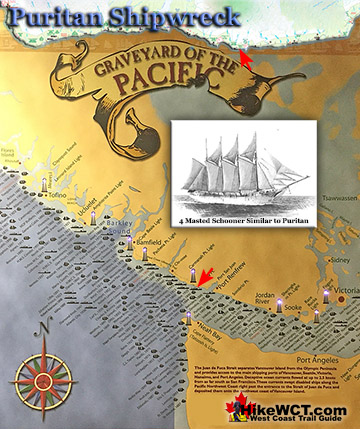
![]() The Puritan was a 4 masted schooner of 614 tons sailing inbound from San Francisco in ballast. She was heading for Port Gamble in Washington to pick up a load of lumber when the crew failed to account for the strong current in Juan de Fuca Strait. Owing to the thick fog and heavy seas, the Puritan stumbled blindly into the rocks of Bonilla Point.
The Puritan was a 4 masted schooner of 614 tons sailing inbound from San Francisco in ballast. She was heading for Port Gamble in Washington to pick up a load of lumber when the crew failed to account for the strong current in Juan de Fuca Strait. Owing to the thick fog and heavy seas, the Puritan stumbled blindly into the rocks of Bonilla Point.
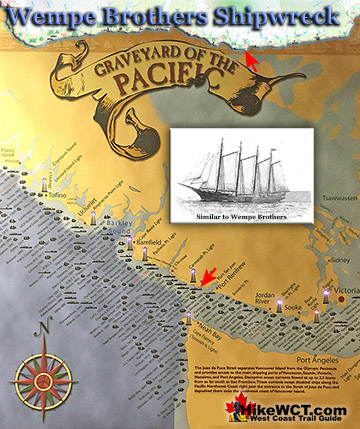
![]() Just as you pass the 49 kilometre mark of the West Coast Trail you will pass the Wempe Brothers shipwreck. A 4 masted, wooden schooner of 681 tons, quite a large sailing vessel for her time. The Wempe Brothers was smashed on the beach here on October 28th, 1903, just a couple kilometres from the Carmanah lighthouse.
Just as you pass the 49 kilometre mark of the West Coast Trail you will pass the Wempe Brothers shipwreck. A 4 masted, wooden schooner of 681 tons, quite a large sailing vessel for her time. The Wempe Brothers was smashed on the beach here on October 28th, 1903, just a couple kilometres from the Carmanah lighthouse.
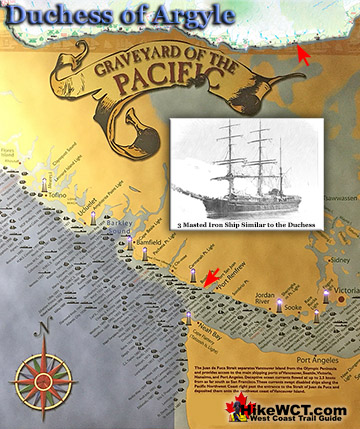
![]() The Duchess of Argyle shipwreck lays at the bottom of the sea at the mouth of Cullite Cove near the 58 kilometre mark of the West Coast Trail. Cullite Cove is by far, one of the best campsites on the West Coast Trail. She was a huge, four masted barque with an iron hull and watertight bulkheads. By way of comparison, at 1700 tons, the Duchess of Argyle was almost four times as large as the Lizzie Marshall.
The Duchess of Argyle shipwreck lays at the bottom of the sea at the mouth of Cullite Cove near the 58 kilometre mark of the West Coast Trail. Cullite Cove is by far, one of the best campsites on the West Coast Trail. She was a huge, four masted barque with an iron hull and watertight bulkheads. By way of comparison, at 1700 tons, the Duchess of Argyle was almost four times as large as the Lizzie Marshall.
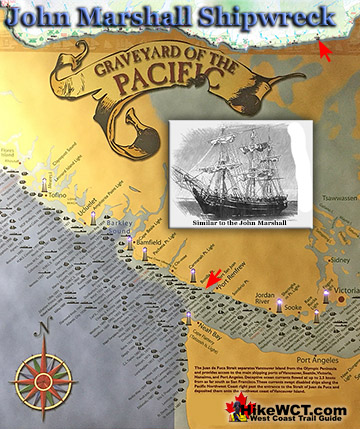
![]() The John Marshall shipwreck is located under the waves just outside the mouth of Camper Bay at the 62 kilometre mark of the West Coast Trail. Owing to the great difficulty and slow progress hikers are forced to take on this section of the West Coast Trail, nearly everyone camps at Camper Bay. If you do, you will be sleeping near this shipwreck that occurred here in 1860.
The John Marshall shipwreck is located under the waves just outside the mouth of Camper Bay at the 62 kilometre mark of the West Coast Trail. Owing to the great difficulty and slow progress hikers are forced to take on this section of the West Coast Trail, nearly everyone camps at Camper Bay. If you do, you will be sleeping near this shipwreck that occurred here in 1860.
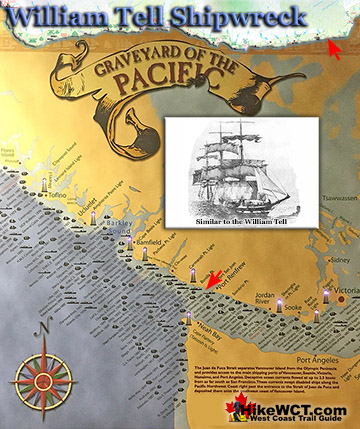
![]() Less than a kilometre past the John Marshall shipwreck you will pass the William Tell shipwreck. Considerably larger than the John Marshall, the William Tell was a 1153 ton, 3 masted ship that wrecked in the Graveyard of the Pacific on December 23rd, 1865. She sailed straight into the reef in front of what is now the 64 kilometre mark of the West Coast Trail.
Less than a kilometre past the John Marshall shipwreck you will pass the William Tell shipwreck. Considerably larger than the John Marshall, the William Tell was a 1153 ton, 3 masted ship that wrecked in the Graveyard of the Pacific on December 23rd, 1865. She sailed straight into the reef in front of what is now the 64 kilometre mark of the West Coast Trail.
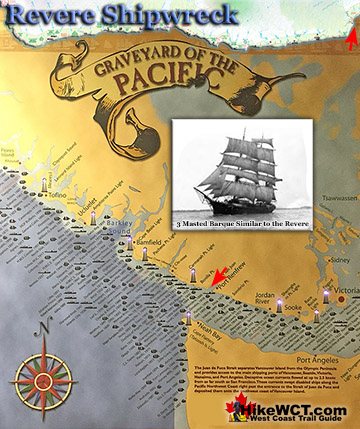
![]() The Revere shipwreck lays at the bottom of Port San Juan between Thrasher Cove and Owen Point. Thrasher Cove is the first or last West Coast Trail campsite you will encounter. She was a large 3 masted barque of 829 tons, built in 1849 in Medford, Massachusetts. She became a victim of the Graveyard of the Pacific on September 9th, 1883.
The Revere shipwreck lays at the bottom of Port San Juan between Thrasher Cove and Owen Point. Thrasher Cove is the first or last West Coast Trail campsite you will encounter. She was a large 3 masted barque of 829 tons, built in 1849 in Medford, Massachusetts. She became a victim of the Graveyard of the Pacific on September 9th, 1883.
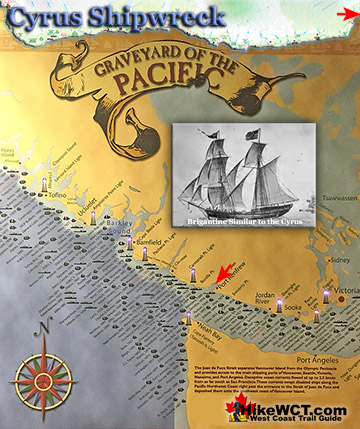
![]() The shipwreck Cyrus is located just down from the West Coast Trail's Gordon River trailhead. If you stand at the wonderful, long, sandy beach that spans the width of Port San Juan and look out over the ocean on your right, you will be looking over the patch of ocean where the Cyrus met her end. The Cyrus was a 213 ton, two masted ship, built in 1832.
The shipwreck Cyrus is located just down from the West Coast Trail's Gordon River trailhead. If you stand at the wonderful, long, sandy beach that spans the width of Port San Juan and look out over the ocean on your right, you will be looking over the patch of ocean where the Cyrus met her end. The Cyrus was a 213 ton, two masted ship, built in 1832.
West Coast Trail Guide
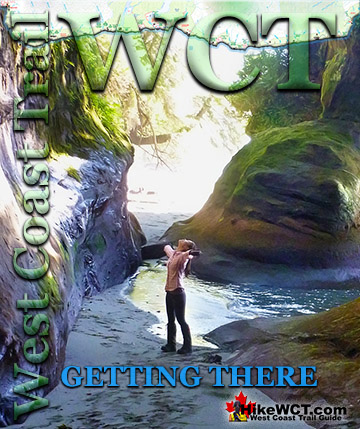
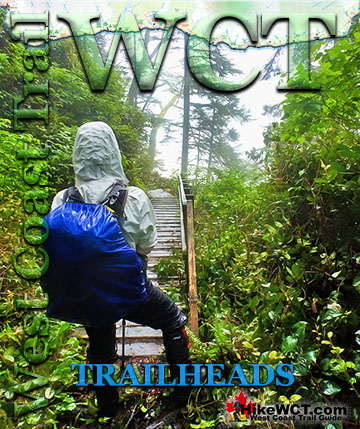

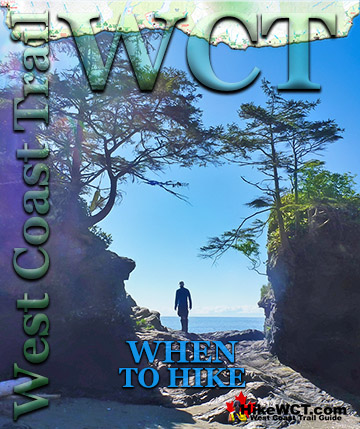
The Valencia Disaster
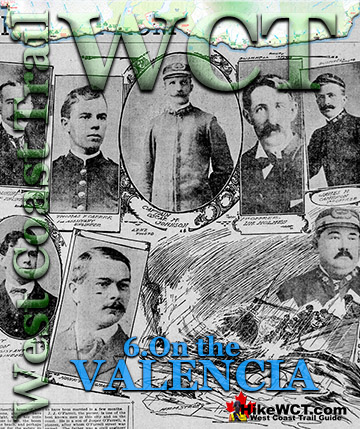
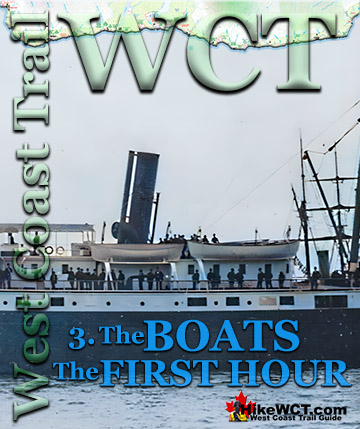
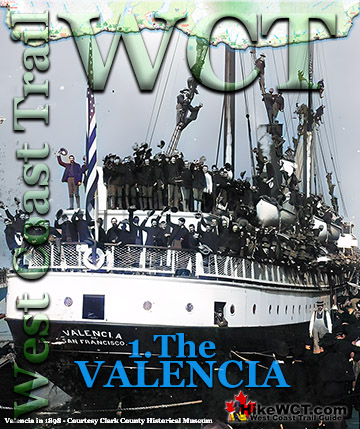
West Coast Trail Campsites

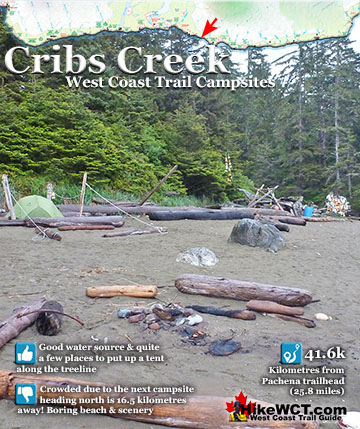
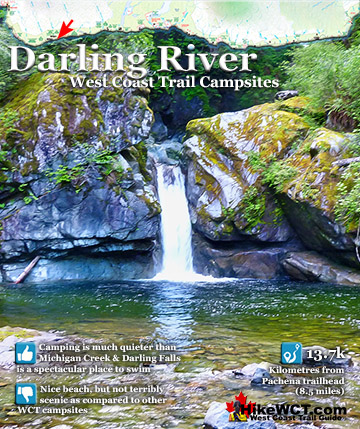

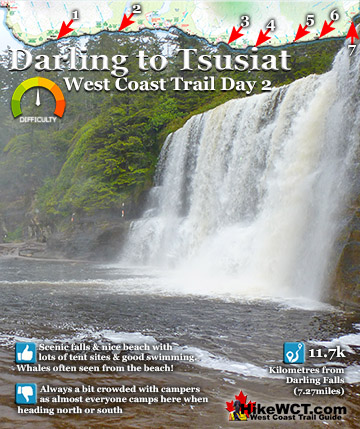
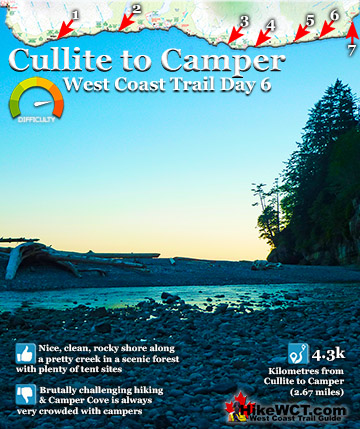
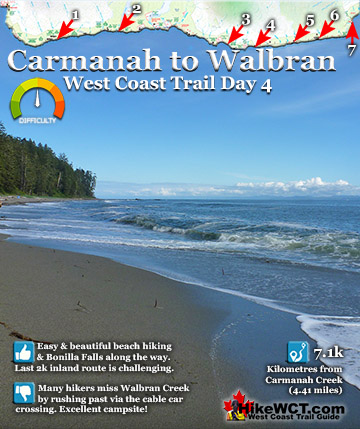
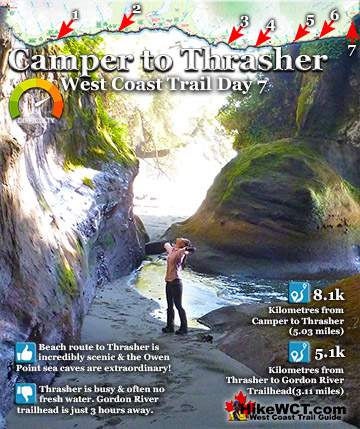
Books About West Coast Trail Shipwrecks
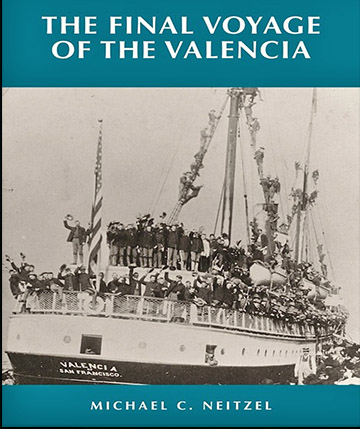
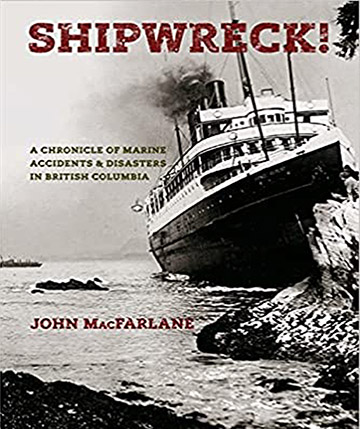
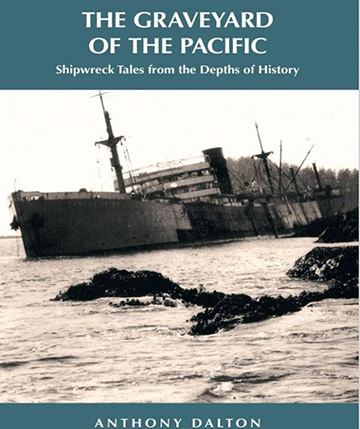

West Coast Trail A to Z
